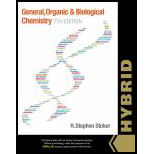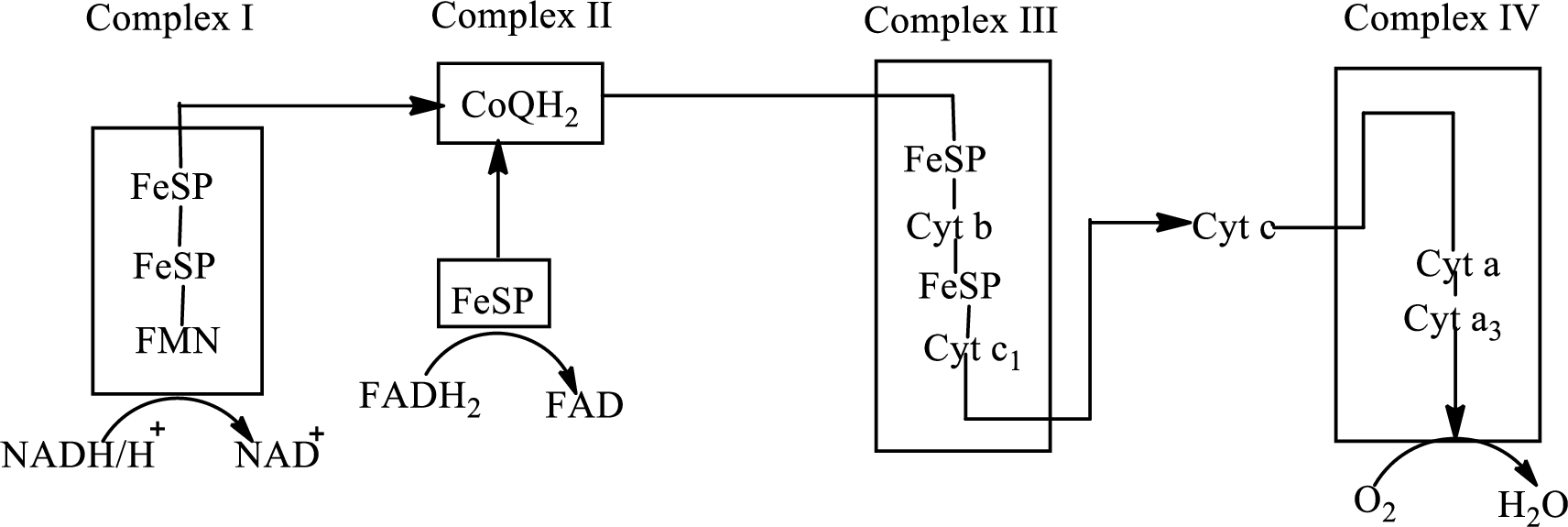
Concept explainers
(a)
Interpretation: To identify whether the list of the electron carrier
Concept introduction: Electron transport chain is a sequence of biochemical reactions in which electrons and hydrogen atoms from the citric acid cycle are transferred to various intermediate carriers and finally reacts with molecular oxygen to form a water molecule.
There are four complexes associated with the electron transport chain that is present in the inner mitochondrial membrane. The four complexes that help in the electron transfer in the electron transport chain are:
Complex I:
Complex II:
Complex III:
Complex IV:
An overview of the electron transport chain is as follows:

(a)
Answer to Problem 23.85EP
Yes, the given order for electron carriers
Explanation of Solution
In the electron transport chain, electrons are transferred from complex I and II to complex III through
(b)
Interpretation: To identify whether the list of the electron carrier
Concept introduction: Electron transport chain is a sequence of biochemical reactions in which electrons and hydrogen atoms from the citric acid cycle are transferred to various intermediate carriers and finally reacts with molecular oxygen to form a water molecule.
There are four complexes associated with the electron transport chain that is present in the inner mitochondrial membrane. The four complexes that help in the electron transfer in the electron transport chain are:
Complex I:
Complex II:
Complex III:
Complex IV:
An overview of the electron transport chain is as follows:

(b)
Answer to Problem 23.85EP
No, the given order for electron carriers
Explanation of Solution
In the electron transport chain, electrons are transferred from complex I and II to complex III through
(c)
Interpretation: To identify whether the list of the electron carrier
Concept introduction: Electron transport chain is a sequence of biochemical reactions in which electrons and hydrogen atoms from the citric acid cycle are transferred to various intermediate carriers and finally reacts with molecular oxygen to form a water molecule.
There are four complexes associated with the electron transport chain that is present in the inner mitochondrial membrane. The four complexes that help in the electron transfer in the electron transport chain are:
Complex I:
Complex II:
Complex III:
Complex IV:
An overview of the electron transport chain is as follows:

(c)
Answer to Problem 23.85EP
No, the given order for electron carriers
Explanation of Solution
In the complex I initially, NADH is oxidized and releases two electrons that reduce
(d)
Interpretation: To identify whether the list of the electron carrierFADH2, NADH and
Concept introduction: Electron transport chain is a sequence of biochemical reactions in which electrons and hydrogen atoms from the citric acid cycle are transferred to various intermediate carriers and finally reacts with molecular oxygen to form a water molecule.
There are four complexes associated with the electron transport chain that is present in the inner mitochondrial membrane. The four complexes that help in the electron transfer in the electron transport chain are:
Complex I:
Complex II:
Complex III:
Complex IV:
An overview of the electron transport chain is as follows:

(d)
Answer to Problem 23.85EP
No, the given order for electron carriers
Explanation of Solution
In complex I, electrons are transferred from the
Want to see more full solutions like this?
Chapter 23 Solutions
General, Organic, And Biological Chemistry, Hybrid (with Owlv2 Quick Prep For General Chemistry Printed Access Card)
- The above product water molecules are generated in which eukaryotic cell compartment?A. the mitochondrial matrix (site of the Krebs cycle)B. the thylakoid membrane of chloroplasts (site of photosystems I and II)C. the chloroplast stroma (site of the Calvin cycle)D. the inner mitochondrial membrane (site of electron transport)E. the cytoplasm (site of glycolysis)arrow_forwardWhich of the following is an electron carrier that shuttles electrons between various protein complexes in the electron transport chain?* a.FMN b.NADH c.Cyt c d.Cyt a3arrow_forwardRapidly dividing cells such as bone marrow, skin, intestinal mucosa, and cancer cells need DNA synthesis. In these cells, the following is observed: a. a decreased NADPH / NADP+ ratio b. increased flux through the oxidative reactions c. Flux through the oxidative reactions is low and the nonoxidative reactions are reversed to make ribose 5-phosphate. d. Ribose 5-phosphate is recycled through the oxidative steps via the nonoxidative reactions and gluconeogenesis. e. Ribose 5-phosphate is shunted into glycolysis by the nonoxidative reactions.arrow_forward
- Which of the following electron carriers are in the reduced form? Note - there may be more than one. A. FAD B. FADH2 C. NAD+ D. NADH E. NADP+arrow_forwardIn chemiosmotic phosphorylation, what is the most direct source of energy that is used to convert ADP + Pi to ATP? A. No external source of energy is required because the reaction is exergonic. B. energy released from high energy electrons given by NADH and FADH2 C. energy released from ATP synthase pumping hydrogen ions from the mitochondrial matrix D. energy released as electrons flow through the electron transport system E. energy released from movement of protons through ATP synthase F. energy released from substrate-level phosphorylationarrow_forwardFor each statement below, write whether the event occurs in GLYCOLYSIS, KREBS CYCLE, or ELECTRON TRANSPORT CHAIN. 1. Oxygen is the final acceptor of electrons 2. Occurs outside the mitochondria 3. Produces FADH2 4. Begins with glucose 5. Occurs in the mitochondrial matrix 6. Ends with pyruvic acid 7. Where chemiosmosis occurs 8 .Forms water 9.Occurs in the inner membrane of the mitochondria 10. Produces the most ATParrow_forward
- Arrange the following in the order they appear in electron transport. a. FAD, coenzyme Q, cytochrome c Ob. FAD, cytochrome c, coenzyme Q Oc. Cytochrome c, FAD, coenzyme Q Od. Coenzyme Q, FAD, cytochrome carrow_forward1)Where is the most Potential Energy Stored at the end of the Citric Acid Cycle? A. High energy electron NADH B. Electron Tansport chain C. G3P D. ATP molecuoles 2) The movement of several solutes simoultanously a. Simple diffusion b. bulk transport c. Passive trasnsport d. Active Trasnport E. Osmosis 3) What is the source of electrons for photosysthesis? a. Oxygen b. ATP c. water D. Glucose E. Carbon dioxide 3) Movement of several solute acrossss cocentration graidients A. Simple diffusion B. Bulk transpoert C. Passive trasnport D. Active Transport E. Facilitated diffusionarrow_forwardWhich chemical equation represents the breakdown of organic carbon (into inorganic form) thattakes place during glycolysis, the Krebs cycle, and electron transport (aerobic respiration)? A. C6H12O6 + C6H12O6 C12H22O11 + H2OB. 6CO2 + 12H2O C6H12O6 + 6O2 + 6H2OC. C12H22O11 + H2O C6H12O6 + C6H12O6D. C6H12O6 + 6O2 + 6H2O 6CO2 + 12H2OE. all of the abovearrow_forward
- Which of the following statements describes the end step for the electron transport chain? A. H+ ions flow down the gradient to generate ATP B. electrons are transferred to NADH and FADH2 for chemiosmosis C. electrons are transferred to oxygen, causing it to split and take up H+ ions, which form water D. H+ are pumped across the inner membrane of mitochondria to establish an electrochemical gradientarrow_forwardin one of the reactions in the electron transport chain, complex I transfer electrons to coenzyme Q. which molecule is reduced and which is oxidized in this reaction? a. complex I is reduced b/c it loses electrons, and Q is oxidized b/c it gains electrons b. complex I is oxidized b/c it loses electrons, and Q is reduced b/c it gains electrons c. complex I is reduced b/c it gains electrons, and Q is oxidized b/c it loses electrons d. complex 1 and Q are both oxidized b/c elections are moved from one molecule to the otherarrow_forwardWhich of the following final electron acceptors is used during anaerobic respiration? a. lactic acid b. pyruvate c. glucose d. nitrate e. waterarrow_forward
 Concepts of BiologyBiologyISBN:9781938168116Author:Samantha Fowler, Rebecca Roush, James WisePublisher:OpenStax College
Concepts of BiologyBiologyISBN:9781938168116Author:Samantha Fowler, Rebecca Roush, James WisePublisher:OpenStax College

